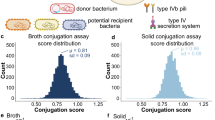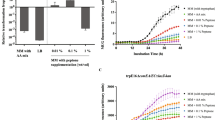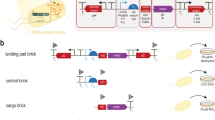Abstract
BACTEBIAL conjugation is now known to be regulated by repression in the same way as many other bacterial functions. Every cell in a culture may carry a sex factor but in only a minority will the factor chance to be de-repressed and the cell be capable of conjugation1,2. The genetic and physiological analysis of conjugation requires mutant sex factors that are no longer subject to repression and which therefore enable all of their host cells to conjugate. Such de-repressed mutants can be selected by replica plating when the sex factor is linked to a selective marker like antibiotic-resistance, because those recipient cells acquiring the factor can be selected by their antibiotic resistance3. Many sex factors, however, are not associated with selective markers and replica plating cannot then be used. Mating in broth provides an alternative method that is applicable whether or not a selective marker is available and which, moreover, is more powerful than replica plating. The same argument underlies the qualitative method devised independently by Ohki and Ozeki4. The conditions described here give even greater selection than those of our original note5 and have been applied to the isolation of de-repressed mutants of colicin factor Ela (Col Ela: ref. 6) and of Col Ib-P9, well known as a sex factor in Salmonella typhimurium6.
This is a preview of subscription content, access via your institution
Access options
Subscribe to this journal
Receive 51 print issues and online access
$199.00 per year
only $3.90 per issue
Buy this article
- Purchase on Springer Link
- Instant access to full article PDF
Prices may be subject to local taxes which are calculated during checkout
Similar content being viewed by others
References
Lawn, A. M., Meynell, E., Meynell, G. G., and Datta, N., Nature, 216, 343 (1967).
Meynell, E., Meynell, G. G., and Datta, N., Bact. Rev., 32, 55 (1968).
Meynell, E., and Datta, N., Nature, 214, 885 (1967).
Ohki, M., and Ozeki, H., Science (in the press).
Edwards, S., and Meynell, G. G., Microbial Genet. Bull., No. 25, p. 4 (1967).
Meynell, G. G., and Lawn, A. M., Genet. Res. Camb., 10, 323 (1967).
Ozeki, H., Howarth, S., and Clowes, R. C., Nature, 190, 986 (1961).
Smith, S. M., and Stocker, B. A. D., Brit. Med. Bull., 18, 46 (1962).
Ozeki, H., Zentbl. Bakt. ParasitKde., Abt. l, Orig., 196, 160 (1965).
Meynell, G. G., and Lawn, A. M., Genet. Res. Camb., 9, 359 (1967).
Meynell, G. G., and Lawn, A. M., Nature, 217, 1184 (1968).
Author information
Authors and Affiliations
Rights and permissions
About this article
Cite this article
EDWARDS, S., MEYNELL, G. General Method for Isolating De-repressed Bacterial Sex Factors. Nature 219, 869–870 (1968). https://doi.org/10.1038/219869a0
Received:
Revised:
Published:
Issue Date:
DOI: https://doi.org/10.1038/219869a0
This article is cited by
-
Derepression of single-stranded DNA-binding protein genes on plasmids derepressed for conjugation, and complementation of an E. coli ssb -mutation by these genes
Molecular and General Genetics MGG (1986)
-
The kinetics of bacterial DNA synthesis during indirect induction of prophage λ
Molecular and General Genetics MGG (1972)
-
R factor compatibility groups
Molecular and General Genetics MGG (1972)
-
Pleiotropic effects of de-repressed bacterial sex factors on colicinogeny and cell wall structure
Molecular and General Genetics MGG (1970)
-
Isolation of conjugation-constitutive mutants of colicin factor Ib
Molecular and General Genetics MGG (1968)
Comments
By submitting a comment you agree to abide by our Terms and Community Guidelines. If you find something abusive or that does not comply with our terms or guidelines please flag it as inappropriate.



